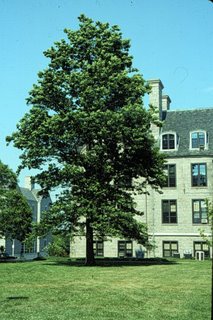Neighbors
By Barbara Currier Bell
Each day, awakening, I glance out my bedroom window at the apartment building across the street. This six-storied, mixed residential and commercial space, standing at the front of a 50’ X 60’ lot, has a relatively small footprint, perhaps 5’ x 5’, but it’s easily the biggest structure on the block. It’s a tree. Experts in its particular architecture would describe it as an exceptionally large example of pin oak, Quercus palustris.
It’s the ultimate in modern design. All the interior living and working spaces have views to the outside, with excellent light and ventilation. The overall look is complex and daring. Numerous intricate, decorative motifs are held together in a simple, solid, but sweeping frame. The viewer is pulled inward and upward simultaneously—welcomed, but at the same time challenged and enlightened. In an imaginative touch, the building’s outer envelope changes color and texture during each season.
The engineering is next-century. Self-assembly from nano-materials has been employed, via solar energy. Each system in the building is environmentally sustainable. Many advanced technologies have been incorporated, such as geothermal heating, and even experimental ones based on processes only dimly understood, such as hydraulics that defy gravity.
But in the morning light, hesitantly reconnecting with life, I don’t think about any of these artistic or technological marvels. I just watch my tree-dwelling neighbors. They get up, eat breakfast, and go about their daily routine. Their apartments are too tiny to spy, but I can hear wrens singing in the shower, and cardinals calling their kids. “Awake!” is a piercing initial call, followed by “Tsk, tsk” as if to chide the lazy ones, then the same cycle repeated. Next, everyone emerges to eat at cafeterias scattered throughout the building. Woodpeckers dart from one counter to another, peck smartly at their food, and dash off. A nuthatch goes downstairs head-first, a little jerkily, to dine.
After refreshment during the cooler moments of the day, it’s commuting time—only a short interval, because of the mixed character of the living-space—and then the bustle at work. Squirrels are entrepreneurs in the food industry, vertically integrated at each centralized location. They plant crops and pick them, like farmers, but they also process food, package, transport, and market it. Insects toil at the infrastructure. They do general maintenance tasks, such as garbage removal, and specialized ones, such as soil testing and treatment, or handling medical wastes. As in every community, the infrastructure workers, while much more numerous than the entrepreneurs, are much less visible. But weather counts, too. A sunny, breezy day means everyone is coming and going, including visiting cats, dogs, and children, whereas rain makes everyone shut their doors.
I don’t glance at the state-of-the-art building across the street every morning because I’m fantasizing my own private “Rear Window”: I’m just getting my daily grip. “Am I awake? Yup…so’s the world. See, that’s the pin oak, where a lot of my neighbors live. We recognize this place, each other. We’re all still here.”


